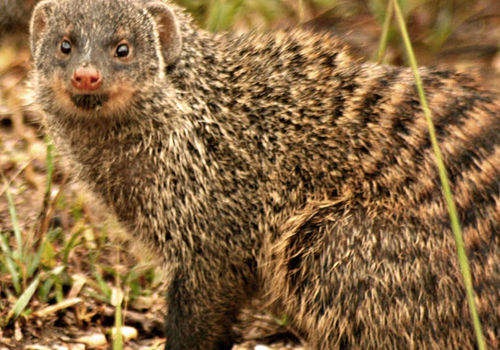
Banded mongoose
Mungos mungoBanded mongoose
Introduction: Banded mongooses (Mungos mungo) are a sturdy little animal with a large head, small ears, short, muscular limbs and a long tail, almost as long as the rest of the body. They live in regions of dry, thorny bushland, open savannah, or open forest and grassland areas, especially near water. The banded mongoose is especially common in areas with many termite mounds that serve as housing and food.
Banded mongoose are gregarious and live in mixed-sex groups of between 6-40 individuals, averaging ±20). These groups sleep together at night in underground dens, which are often abandoned termite mounds. They are known to change den frequently, up to every 2-3 days,is not unusual.
Distribution: The banded mongoose lives in open savannah, open forests and grassland, especially near water, but also in dry, thorny bushland. Namutoni Restcamp in Etosha National Park is a good place to see them close up.
Diet: They dig up most of the their food, such as insects and grubs, with their strong claws. They are also partial to snails, small reptiles, wild fruits and the eggs and young of ground nesting birds.
Colouring: Their rough fur is greyish brown, with several dark brown to black vertical bars across the back. The limbs and snout are darker, while the underparts are lighter than the rest of the body.
Breeding: Litters of between 2 and 8 pups are born in grass-lined chambers in their warrens, in holes in the ground or in termite mounds. Gestation periods are 60 - 70 days and all females in the group give birth on the same day.
Size: Adults are around 55cm long in total length, including the tails which can account for 60% of the length of the head and the body. Both male and female are similar in size and a weight of 1.5 to 2.5kg.
Klein Windhoek

